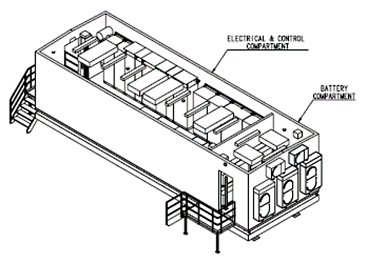
Monitoring and controlling large-scale industrial facilities often takes place within some form of control room. These control rooms can be integrated within the main structure of the facility or exist as standalone units dedicated solely to this purpose. In energy production facilities, for instance, the control room often takes the form of a standalone unit situated near a gas turbine. Within the control room, power distribution is coordinated, turbine operations are regulated, and meticulous monitoring occurs.
Standalone control rooms find utility across various facility types, with common areas including the oil and gas industry as well as power generation.

Elektromontage has the capability to assist customers in delivering an essentially turnkey solution when it comes to control rooms. In collaboration with partners, Elektromontage offers tailored solutions encompassing design, execution, and control room prerequisites. Solutions can range from approximately 10-meter-long structures supported by metal pillar constructions to versions reaching up to 18 meters for placement on concrete foundations. Roof pitch, wall design, ventilation, and flooring materials - everything can be customized to align with the customer's preferences. Elektromontage not only installs but also integrates the components provided by the customer, such as control cabinets and safety solutions, alongside the components contributed by Elektromontage to the project - such as MCCs, battery systems, and apparatus cabinets. Installation, testing, and verification are conducted within Elektromontage's facilities in close collaboration with the end customer.
With over a decade of experience delivering various types of control rooms across different continents, our customers find in Elektromontage an experienced and dependable partner that upholds quality and customer satisfaction to the highest degree.

A standalone control room goes by various designations and adheres to diverse requirements. Some clients refer to it as a "Local Equipment Room" (LER), while others prefer the term "Power Control Module" (PCM), despite the same fundamental function. Essentially, the control room represents a distinct building that unifies all processes critical to the facility's operation. Here, Motor Control Centers (MCCs) facilitate power distribution to the facility's motors and consumers. Control cabinets and apparatus cabinets contribute to process regulation, while battery systems and auxiliary power strengthen emergency and safety systems. The specifics depend on the specific process and facility in question. Different facilities may demand different features, but ultimately, the requirements for control rooms converge in their commitment to creating a secure, comfortable, and reliable working environment for operators. This holds true regardless of whether the facility endures extreme climates, is located in an earthquake-prone area, or faces the risk of gas-related explosions.
The role of the control system in a gas turbine is to regulate fuel flow and manage turbine speed, ensuring stable operation and optimal power output. By adjusting fuel flow, the control system maintains the desired power turbine speed, regardless of load or variations in fuel quality. In many applications, control systems also use cascade control strategies, where the speed setpoint is dynamically adjusted to meet power demands or optimize efficiency. Control systems are critical for ensuring safe operation, improving fuel efficiency, and minimizing emissions, making them essential for effective gas turbine performance in power generation and industrial applications.
The three primary components of a gas turbine are the compressor, combustor, and turbine: 1) The compressor draws in air and compresses it to high pressure, increasing its potential energy. 2) The combustor then injects fuel into the compressed air and ignites the mixture, creating high-temperature, high-pressure gases. 3) Finally, the turbine extracts energy from the hot gases, converting it into rotational energy to drive both the compressor and external load, such as a generator or mechanical drive. Together, these components allow the gas turbine to efficiently generate power in industrial and energy applications.
The primary difference between gas turbines and steam turbines is their source of energy. Gas turbines generate power by combusting a fuel-air mixture to produce high-speed, high-temperature gases that drive the turbine blades. In contrast, steam turbines use high-pressure steam, typically generated by boiling water in a boiler, to turn the turbine blades. Gas turbines are often used in power plants and industrial settings where quick start-up and high power output are needed, while steam turbines are more common in applications where steam is readily available, such as combined-cycle power plants and cogeneration systems. Each type has distinct advantages depending on fuel sources, operational needs, and efficiency requirements.